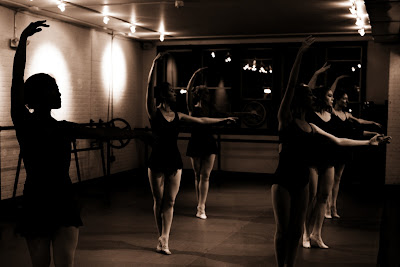-engage latissimus dorsi; the difference between buoyed arms and flat, lifeless ones lies in the engagement of these broadest muscles of the back
-Russian ballet dancers ponder the Questions of the Universe only in passing
-similarly, the grand plie is in essence a position assumed over a toilet or hole and is not to be dwelled on; as a concrete example
-in our new set plies, this "pondering" look under the high arm coincides with the bottom of the grand plie because both indicate that the combination has not yet reached its conclusion
-in passe-plie-developpe, the plie is delayed; the rotators are relaxed; pull comes from the knee
-4-5! 2-5! 2-3-5!
-shoulder phone chat transcription: "Hello! Hi there! I'm in ballet class!"
-every time we throw confetti in the air, a small part of Kip dies inside
-to know, or to KNOW; there is a difference
Form fits function
-rounded shoulders and the "look of the lyre" reflect fleeting, stylistic notions of their respective era
-when you strip ballet of style, what is left is pure, unadulterated function
-
The Principle of Purposeful Movement: the 'Modern architectural' view of academic, classical ballet is founded on this notion that the beauty of a given pose or movement arises naturally from its function with respect to the human body; for instance:
-the
port-de-corp en rond demonstrates a torquing of the body from the scapula, not the shoulders; shoulders should remain depressed and in their sockets
-the coupe in
coupe pas-de-bourree is not an arbitrary pose; it has a purposed function, which is to initiate movement; thus, it should be performed as such (ie: with a great sense of movement being initiated)
-the function of the 3rd port-de-bras is to show plasticity of form, esp. the legs & spine; the hand speaks volumes and must therefore be immediately tucked in out of the way



